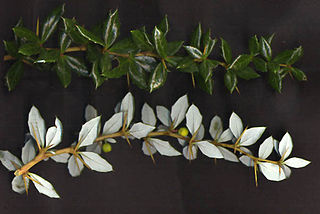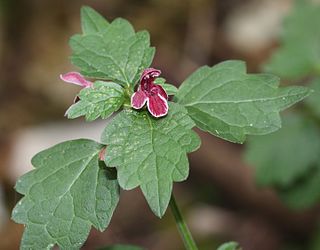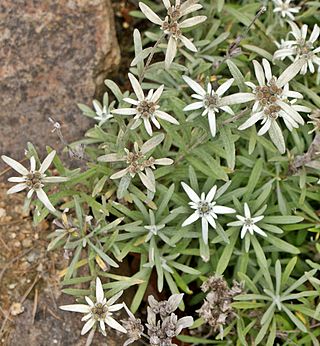
Asarum is a genus of plants in the birthwort family Aristolochiaceae, commonly known as wild ginger.

Berberis verruculosa, the warty barberry or warted barberry, is an evergreen shrub in the family Berberidaceae. It ranges in size from 1–2 m, and is native to western China. It gets its common name from its "warty" stems, that have rounded, more or less identical, raised spots.
Heliotropium pannifolium, the Saint Helena heliotrope, is now extinct but was formerly a hairy-leaved small shrub in the family Boraginaceae. It grew to a height of up to 1 m. It was only seen once, by the explorer W. Burchell in Broad Gut, Saint Helena and has never been seen again. Human impact on the island of Saint Helena was severe and the Saint Helena heliotrope is one of several extinct plants from that island.
Scalesia retroflexa is a species of flowering plant in the family Asteraceae. It is found only in the Galápagos Islands of Ecuador. It is threatened by habitat loss.

Aristolochia westlandii is a species of plant in the family Aristolochiaceae. It is found in China and Hong Kong, in valley forests in Guangdong Province at an elevation of 300 to 800 metres. The leaves are long, narrow and pointed. The flowers are bent tubes from 10–15 centimetres (3.9–5.9 in) long that grow from the base of a leaf. They are yellow with purple veins and blotches.
Asarum crispulatum is a species of plant in the family Aristolochiaceae. It is endemic to China.
Polyscias crassa is a species of plant in the family Araliaceae. It is endemic to Seychelles. It is threatened by habitat loss.
Gymnadenia crassinervis is a species of plant in the family Orchidaceae. It is endemic to China.
Habenaria delavayi is a species of plant in the family Orchidaceae. It is endemic to China.
Hemipilia camptoceras is a species of plant in the family Orchidaceae. It is endemic to the Sichuan region of China.
Oreopanax sanderianus is a species of plant in the family Araliaceae. It is found in Guatemala, Honduras, and Mexico. It is threatened by habitat loss.
Saurauia oreophila is a species of flowering plant in the family Actinidiaceae. It is found in Guatemala and Mexico. It is threatened by habitat loss.
Saurauia scabrida is a species of flowering plant in the family Actinidiaceae. It is endemic to Mexico.
Astropanax procumbens is a species of plant in the family Araliaceae. It is endemic to Seychelles, now confined to six small areas on Silhouette Island at elevations between 400 and 700 meters, having become extinct on Mahé.

Loxocalyx is a genus of plants in the family Lamiaceae, first described in 1891. It is native to China and Japan.

Aloe cameronii is a species of flowering plant in the family Asphodelaceae. It is indigenous to Malawi and Zimbabwe.

Leontopodium sinense is a species of plant in the family Asteraceae. It is native to China.

Leontopodium stracheyi is a species of plant in the family Asteraceae. It is native to China, Bhutan, India and Nepal.
Ainsliaea elegans is a species of flowering plants in the family Asteraceae. It is found in China and Vietnam.
Anaxagorea crassipetala is a species of understory tree in the family Annonaceae. It is found frequently in the lowland rainforests of Costa Rica and Panama, but extends down to Peru.








